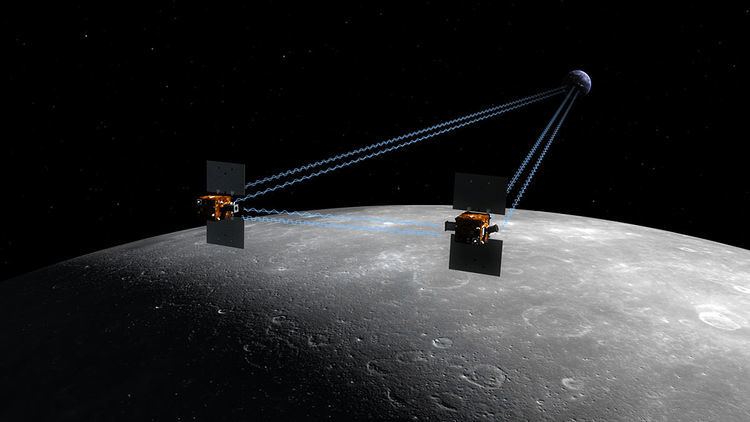Operator NASA / JPL SATCAT no. 37801, 37802 Mission duration 9 months | COSPAR ID 2011-046 (A, B) Website moon.mit.edu | |
 | ||
Manufacturer Massachusetts Institute of Technology, LMSS | ||
The Gravity Recovery and Interior Laboratory (GRAIL) was an American lunar science mission in NASA's Discovery Program which used high-quality gravitational field mapping of the Moon to determine its interior structure. The two small spacecraft GRAIL A (Ebb) and GRAIL B (Flow) were launched on 10 September 2011 aboard a single launch vehicle: the most-powerful configuration of a Delta II, the 7920H-10. GRAIL A separated from the rocket about nine minutes after launch, GRAIL B followed about eight minutes later. They arrived at their orbits around the Moon 25 hours apart. The first probe entered orbit on 31 December 2011 and the second followed on 1 January 2012. The two spacecraft impacted the Lunar surface on December 17, 2012.
Contents
Overview
Maria Zuber of the Massachusetts Institute of Technology is GRAIL's principal investigator. NASA's Jet Propulsion Laboratory manages the project. As of August 5, 2011, the program has cost US$496 million. Upon launch the spacecraft were named GRAIL A and GRAIL B and a contest was opened to school children to select names. Nearly 900 classrooms from 45 states, Puerto Rico and the District of Columbia, participated in the contest. The winning names, Ebb and Flow, were suggested by 4th grade students at Emily Dickinson Elementary School in Bozeman, Montana.
Each spacecraft transmitted and received telemetry from the other spacecraft and Earth-based facilities. By measuring the change in distance between the two spacecraft, the gravity field and geological structure of the Moon was obtained. The two spacecraft were able to detect very small changes in the distance between one another. Changes in distance as small as one micron were detectable and measurable. The gravitational field of the Moon was mapped in unprecedented detail.
Objectives
The data collection phase of the mission lasted from 7 Mar 2012 to 29 May 2012, for a total of 88 days. A second phase, at a lower altitude, of data collection began 31 Aug 2012, and was followed by 12 months of data analysis. On 5 Dec 2012 NASA released a gravity map of the Moon made from GRAIL data. The knowledge acquired will aid understanding of the evolutionary history of the terrestrial planets and computations of lunar orbits.
Instruments
Propulsion
Thrusters aboard each spacecraft were capable of producing 22 newtons (4.9 lbf). Each spacecraft was fueled with 103.5 kilograms (228 lb) of hydrazine to be used by the thrusters and main engine to enable the spacecraft to enter lunar orbit and transition to the science phase of its mission. The propulsion subsystem consisted of a main fuel tank and a Re-repressurization system which were activated shortly after lunar orbit insertion.
Launch attempts
All times are in EDT (UTC-4).
Transit phase
Unlike the Apollo program missions, which took three days to reach the Moon, GRAIL made use of a three- to four-month low-energy trans-lunar cruise well outside the Moon's orbit and passing near the Sun-Earth Lagrange point L1 before looping back to rendezvous with the Moon. This extended and circuitous trajectory enabled the mission to reduce fuel requirements, protect instruments and reduce the velocity of the two spacecraft at lunar arrival to help achieve the extremely low 50 km (31 mi) orbits with separation between the spacecraft (arriving 25 hours apart) of 175 to 225 km (109 to 140 mi). The very tight tolerances in the flight plan left little room for error correction leading to a launch window lasting one second and providing only two launch opportunities per day.
Science phase
The primary science phase of GRAIL lasted for 88 days, from 7 Mar 2012 to 29 May 2012. It was followed by a second science phase starting on 8 Aug.
The gravity mapping technique was similar to that used by Gravity Recovery and Climate Experiment (GRACE), and the spacecraft design was based on XSS-11.
The orbital insertion dates were December 31, 2011 (2011-12-31) (for GRAIL-A) and January 1, 2012 (2012-01-01) (for GRAIL-B).
The spacecraft were operated over the 88-day acquisition phase, divided into three 27.3 day long nadir-pointed mapping cycles. Twice each day there was an 8-hour pass in view of the Deep Space Network for transmission of science and "E/PO MoonKam" data.
Final experiment and mission end
At the end of the science phase and a mission extension, the spacecraft were powered down and decommissioned over a five-day period. The spacecraft impacted the lunar surface on December 17, 2012. Both spacecraft impacted an unnamed lunar mountain between Philolaus and Mouchez at 75.62°N 26.63°W / 75.62; -26.63. Ebb, the lead spacecraft in formation, impacted first. Flow impacted moments later. Each spacecraft was traveling at 3,760 miles per hour (1.68 km/s). A final experiment was conducted during the final days of the mission. Main engines aboard the spacecraft were fired, depleting remaining fuel. Data from that effort will be used by mission planners to validate fuel consumption computer models to improve predictions of fuel needs for future missions. NASA has announced that the crash site will be named after GRAIL collaborator and first American woman in space, Sally Ride.
